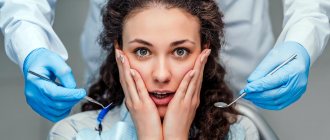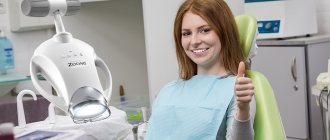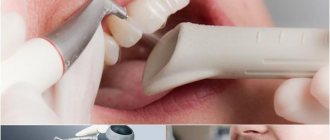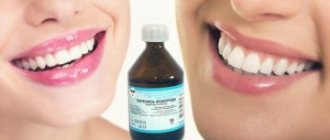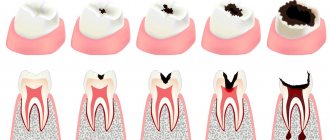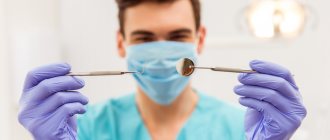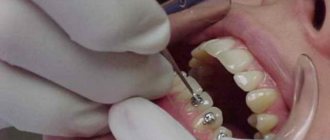Hydrogen peroxide is widely used in various fields of medicine. Several years ago, scientists announced that this substance could help fight tooth decay. Is it possible to treat caries with hydrogen peroxide, what methods are used in modern dentistry? Read about this in our article.
In this article
- Features of the use of hydrogen peroxide in dentistry
- Hydrogen peroxide in the treatment of caries
- Hydrogen peroxide in home treatment of caries
- Current methods of caries treatment
- Conclusion
Features of the use of hydrogen peroxide in dentistry
Hydrogen peroxide is an antiseptic solution based on 3% hydrogen peroxide. It has a powerful disinfectant and antibacterial effect and quickly stops bleeding. Due to these properties, peroxide is widely used in dental practice. In particular, hydrogen peroxide is used to treat the mucous membranes of the oral cavity for periodontitis, gingivitis, stomatitis, to disinfect the edges of the socket after tooth extraction, and to treat ulcers. The product is also used in the procedure for whitening tooth enamel, removing pigment spots and plaque from it. Peroxide is the main component of whitening gels and pastes.
Whitening principle
At the moment, there are two types of whitening - office (professional) and home. Both methods are actively used to improve the color of teeth, but professional whitening is more effective. On the other hand, any type of whitening is based on the same principles. The basis of the bleaching agent is hydrogen peroxide or carbamide. When decomposed, free radicals are released, namely atomic oxygen, which effectively destroys dyes and pigments that accumulate in dentin. The effectiveness of whitening depends on a number of factors, including the concentration of the active substance and the regularity of the procedure.
Hydrogen peroxide in the treatment of caries
The cause of dental caries is the bacteria Streptococcus mutans, which forms dental plaque - a biological bacterial film. These microorganisms feed on sugars that enter the human body along with food, and as a result of their processing they form organic acids. The latter destroy enamel, dentin and other tooth tissues.
Thus, plaque poses a threat to the development of caries. At the same time, biological film is difficult to remove or destroy with modern antimicrobial drugs. Several years ago, a team of scientists conducted research and developed nanoparticles that can destroy the structure of dental biofilm, destroy pathogenic microorganisms and prevent the development of caries.
Nanoparticles consist of iron oxide, polysaccharides and some other substances. When exposed to an acidic environment (and bacteria in dental plaque produce a lot of organic acids), these nanoparticles begin to produce hydrogen peroxide. This compound has a powerful antiseptic effect, destroys pathogenic microorganisms, destroys bacterial dental films, thereby protecting teeth from carious lesions. As part of the study, scientists tested their development on volunteers and came to the conclusion that nano-sized particles effectively destroy tartar and destroy bacteria without causing damage to the enamel or disruption of the microflora in the oral cavity. According to the scientists' findings, the use of nanoparticles with a one percent solution of hydrogen peroxide destroys more than 99% of cariogenic bacteria.
Researchers have suggested adding such particles to toothpastes or mouth rinses, since the use of these products can be an excellent preventive measure for dental caries. The practical application of the development can only be discussed after successful clinical trials. But the antiseptic effect of hydrogen peroxide on cariogenic bacteria is beyond doubt.
Recommendations after whitening
Features of caring for teeth and maintaining their “shape” depend on the type of whitening. Moreover, before the procedure it is necessary to carry out a number of preparatory manipulations.
- Examination of the oral cavity, X-ray examination and identification of possible contraindications. These include cancer, diabetes, allergies to ultraviolet radiation, and active dental diseases. Whitening is also contraindicated for pregnant women and people under 18 years of age.
- Professional oral cleaning.
- In-office whitening usually requires one procedure. After this, remineralizing therapy is carried out, which will restore the enamel after the procedure. To consolidate the results, a course of home whitening is prescribed, which can last up to a month. If the patient wants to undergo only a course of home whitening, he also needs to consult with a doctor, who will also help him choose the optimal system.
Hydrogen peroxide in home treatment of caries
While scientists are looking for new ways to combat caries using hydrogen peroxide, fans of traditional treatment methods are offering their own options. Let us immediately note that any use of peroxide (for the prevention and treatment of caries, oral hygiene) without consulting a doctor can be dangerous to health.
On the Internet you can find dozens of folk recipes that include hydrogen peroxide. The most popular is mouthwash. It has a bactericidal effect, helps reduce pain, inflammation, and eliminate bad breath. In some cases, if indicated, such rinses may be prescribed by a dentist.
But it is important to prepare the solution correctly, otherwise there is a risk of burning the mucous membranes. A rinse solution prepared in the following proportion is considered safe. Add one teaspoon of 3% hydrogen peroxide solution to a glass of warm boiled water and mix thoroughly. Rinse your teeth with a small amount of solution for 5-7 minutes, periodically spitting out the liquid.
When rinsing, do not allow the solution to enter the esophagus and stomach, since peroxide can damage the walls of these organs. That is why you should use rinses based on hydrogen peroxide very carefully, only as prescribed by a doctor. This method should not be used by children.
Teeth whitening: harmful or not?
The procedure is part of cosmetic dentistry, but does not cease to be a medical service. That is why the answer to the question of whether teeth whitening in dentistry is harmful is obvious. When carried out correctly and using certified products and technologies, cosmetic teeth whitening does not pose a health hazard. This is the opinion of experts and researchers.
Current methods of caries treatment
In traditional dental practice, treatment with hydrogen peroxide is not used. In addition, hydrogen peroxide, despite its pronounced antiseptic effect, cannot restore damaged tooth tissue or compensate for the lack of minerals in tooth enamel. Therefore, if you have symptoms of caries, you should not self-medicate. Seek help from a good dental clinic.
Today, caries is treated in two main ways - conservative or surgical. Conservative methods are non-invasive, that is, treatment is carried out without preparing the tooth.
- Remineralization of enamel.
The tooth is coated with compounds that contain phosphorus and calcium ions, the main mineral substances of tooth enamel.
- Fluoridation.
Fluoride-containing gels, varnishes, and pastes are applied to the surface of the teeth, which ensure saturation of the enamel with fluorides. They strengthen the surface of the teeth, increase the resistance of the enamel to the action of bacteria, and protect the teeth from calcium losses.
- ICON method.
Another minimally invasive method of treating carious lesions, which is carried out without drilling or filling the tooth. The dentist alternately applies several compounds to the surface of the tooth, the last of which seals the pores of the tooth enamel. This sealing protects teeth from the penetration of bacteria into deep tissues and prevents the development of caries.
These methods do not cause pain to the patient, so they can be performed without anesthesia. But they give an effective result only if the carious process is at the initial stage and there is no carious cavity in the tooth yet.
If there is a hole in the tooth, caries is treated surgically:
- Cleans enamel from plaque and tartar.
- An anesthetic injection is given if treatment for medium or deep caries is considered.
- The cavity is drilled out and all affected and dead tissue is carefully removed.
- The cavity is disinfected with antiseptics and its walls are coated with an adhesive composition, which will allow the filling to adhere better.
- An insulating or therapeutic pad is placed at the bottom of the cavity to protect the pulp or relieve inflammation.
- The tooth is filled with a suitable material and given its natural shape.
- Grinding and polishing are carried out to align the tooth with the bite and form a smooth, even surface.
A correctly selected treatment method helps to cope with caries at any stage, stop the development of the pathological process, and return the tooth to its natural appearance.
Common myths about teeth whitening
The whitening procedure is surrounded by quite a lot of myths and not entirely correct opinions. Below are the most common ones.
- “Whitening harms tooth enamel.” Today there is practically no debate about whether whitening is harmful to tooth enamel. Does teeth sensitivity increase after whitening? Yes. Does enamel deteriorate? No. Recent studies indicate that frequent whitening procedures can lead to demineralization of the enamel and a decrease in its protective functions (especially with a high concentration of the active substance). That is why experts carry out a remineralization procedure after bleaching, and also recommend avoiding cold and hot foods in the first days. However, it cannot be said that hydrogen peroxide destroys enamel. That is why this statement falls into the category of misconceptions.
- “Whitening results last a lifetime.” This is one of the most common myths associated with teeth whitening. If all recommendations are followed and supportive measures are taken, good teeth color can be maintained for many years, but over time it will still fade somewhat. Moreover, the statement that teeth can be whitened by 10-12 shades is also more of a marketing ploy than the truth. The exact figures depend on several factors, including the individual characteristics of the patients' teeth. In reality, lightening by 8 tones (even with in-office bleaching) is an almost ideal result.
- “Photobleaching is more effective than chemical bleaching.” Some people believe that activating a substance using an ultraviolet lamp allows you to achieve much better results, but this is not so. Of course, a lot depends on the manufacturer, but if we compare the top systems Zoom (photo whitening) and Opalescence (chemical whitening), they are approximately equal in terms of efficiency. This is confirmed by patient reviews.
- “Fillings and crowns can also be whitened.” Unfortunately, this is a myth. That is why the presence of many fillings and crowns (especially in the frontal area) is a limitation for whitening.
- “You don’t have to go to a dental clinic for whitening services.” Professional whitening is carried out only in a dentist’s office in specialized clinics, otherwise there is a risk of not only not getting the desired result, but also of developing a number of serious complications (burns, poisoning, and so on). Home whitening kits can be used outside of a clinic, but even then, it is recommended to consult with a specialist first.
Some tips for use
Before you whiten your teeth with hydrogen peroxide, it is wise to learn some tips.
- The maximum peroxide concentration should be 3%.
- A visually noticeable lightening effect occurs after several procedures, so you will have to be patient.
- The optimal course duration is 2 weeks. They are repeated after 2.5 months.
- If, after treating your teeth with peroxide, you feel a strong burning sensation, pain occurs, and the sensitivity of the enamel increases, you need to abandon this product and choose other bleaches, for example, soda, activated carbon.
Benefits of peroxide for teeth
There are three most popular ways to whiten enamel at home:
- Whitening toothpaste . You can use any paste, but it is best to use one with added fluoride. This minimizes the risk of side effects for the enamel. Apply the paste to the brush, then add a few drops of lemon juice and peroxide. The method is not very gentle, but also not very aggressive.
- Whitening with peroxide and soda . This method is quite effective, since it ensures that two substances work simultaneously. To whiten teeth, you will need 3% peroxide and regular baking soda, all components are mixed until a paste forms. You need to brush your teeth with this composition without using a brush, since the effect on the enamel will be excessively aggressive. Apply the paste with your fingers, massage a little and rinse with water. It is necessary to ensure that the composition does not get on the gums, this can lead to irritation.
- Rinse . 3% peroxide is required, before use it must be diluted with water in a 1:1 ratio. So, the concentration of the composition will be 1.5%. First, brush your teeth with a toothpaste containing fluoride, then rinse your mouth with the solution for a minute. Finish by rinsing your mouth with clean water. After half an hour, the consumption of any food is prohibited.
Tips and how to use it correctly
The recipe for all whitening compositions can cause harm, which can be reduced if you follow certain recommendations:
- Do not expect an immediate effect; as a rule, the result can be seen only after 3-4 days . The total duration of the procedures must be no more than 14 days and no more than four times a year.
- Use peroxide in a concentration of no more than 3% .
- If during the whitening process you begin to experience discomfort, burning or other unpleasant sensations, then immediately complete the whitening, rinse your mouth thoroughly with water and after 2-3 days try another method of removing plaque, for example, using regular soda.
- Before you begin the procedures, be sure to visit the dental office . If the doctor diagnoses tooth decay and damage to the oral cavity, whitening should be postponed until complete healing.
- Always use only fresh peroxide, which is stored in a hermetically sealed jar in the refrigerator. During contact with air, the healing properties are lost.
- Make sure that there is no allergic reaction to the active ingredients of the components used.
Contraindications
Gel teeth whitening has side effects, so it should not be used in the following cases:
- During pregnancy and breastfeeding.
- Patients with caries, gum disease.
- Allergy to the components of the product.
- Crowns and fillings.
- High sensitivity of teeth.
Use teeth whitening gel with caution when correcting a bite with braces. Braces are not a direct contraindication to whitening, but due to the way they are fixed to crowns, the product may be distributed unevenly and stains may appear on the teeth.
